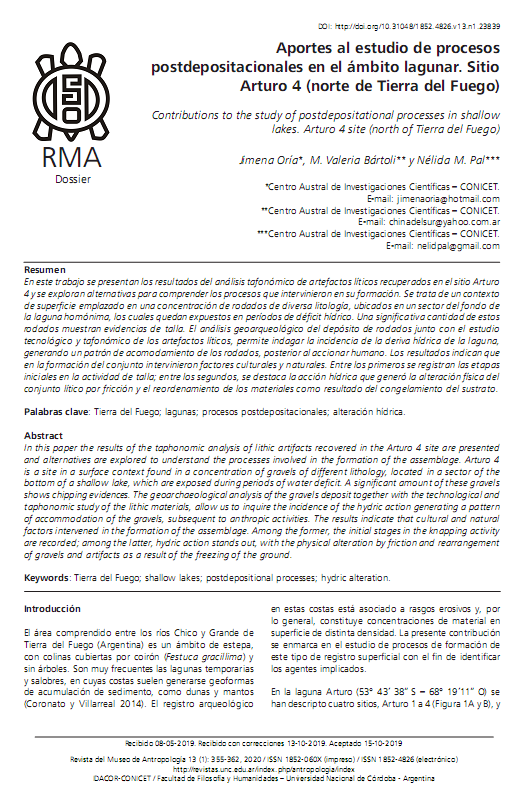Contributions to the study of postdepositational processes in shallow lakes. Arturo 4 site (north of Tierra del Fuego
DOI:
https://doi.org/10.31048/1852.4826.v13.n1.23839Keywords:
Tierra del Fuego, shallow lakes, postdepositional processes, hydric alterationAbstract
In this paper the results of the taphonomic analysis of lithic artifacts recovered in the Arturo 4 site are presented and alternatives are explored to understand the processes involved in the formation of the assemblage. Arturo 4 is a site in a surface context found in a concentration of gravels of different lithology, located in a sector of the bottom of a shallow lake, which are exposed during periods of water deficit. A significant amount of these gravels shows chipping evidences. The geoarchaeological analysis of the gravels deposit together with the technological and taphonomic study of the lithic materials, allow us to inquire the incidence of the hydric action generating a pattern of accommodation of the gravels, subsequent to anthropic activities. The results indicate that cultural and natural factors intervened in the formation of the assemblage. Among the former, the initial stages in the knapping activity are recorded; among the latter, hydric action stands out, with the physical alteration by friction and rearrangement of gravels and artifacts as a result of the freezing of the ground.
Downloads
References
Aschero, C. 1975. Ensayo para una clasificación morfológica de artefactos líticos aplicada a estudios tipológicos comparativos. MS. Informe presentado al CONICET. Buenos Aires.
Aschero, C. 1983. Ensayo para una clasificación morfológica de artefactos líticos. MS. Buenos Aires.
Borrazzo, K. 2006. Tafonomía lítica en dunas; una propuesta para el análisis de los artefactos líticos. Intersecciones en Antropología 7: 247-261.
Borrazzo, K. 2010. Arqueología de los esteparios fueguinos. Tecnología y tafonomía lítica en el norte de Tierra del Fuego. Tesis Doctoral Inédita, Facultad de Filosofía y Letras, UBA.
Borrero, L. A. 2007. Longitudinal taphonomic studies in Tierra del Fuego, Argentina. En M.A. Gutierrez, L. Miotti, G. Barrientos, G. Mengoni Goñalons y M. Salemme (Eds.), Taphonomy and Zooarchaeology in Argentina, pp. 219-233. British Archaeological Reports International Series 1601, Oxford.
Bouza, P. J. 1995. Evolución de pavimentos de desierto y costras superficiales en un sector del Noreste del Chubut : Su relación con las propiedades físico-químicas y micromorfológicas del suelo superficial. Tesis Doctoral Inédita. Facultad de Ciencias Exactas y Naturales, UBA.
Coronato, A., y M. L. Villarreal. 2014. Modelado eólico en ambientes lagunares de la estepa fueguina, Argentina. XIX Congreso Geológico Argentino, Córdoba 2014. CDROM, S13-46. Asociación Geológica Argentina, Buenos Aires.
Dorn, R. I. 2013. Rock coatings. En J. Shroder y G. A. Pope (Eds.), Treatise on Geomorphology, Weathering and Soils Geomorphology, Volúmen 4, pp. 70-97. San Diego: Academic Press.
Orford, J. D., R. W. Carter y S. C. Jennings. 1996. Control domains and morphological phases in gravel-dominated coastal barriers of Nova Scotia. Journal of Coastal Research 12 (3): 589-604.
Orford, J. D., D. L. Forbes y S. C. Jennings. 2002. Organisational controls, typologies and time scales of paraglacial gravel dominated coastal systems. Geomorphology 48: 51-85.
Oría, J. 2014. Tierra adentro. Distribuciones artefactuales y movilidad en la estepa fueguina. En J. Oría y A. M. Tívoli (Eds.), Cazadores de mar y tierra. Estudios recientes en arqueología fueguina, pp. 289-312. Editora Cultural Tierra del Fuego. Ushuaia.
Oría, J. y M. Salemme. 2016. Visibilidad y preservación en Laguna Arturo, norte de Tierra del Fuego (Argentina). Un análisis geoarqueológico. Intersecciones en Antropología Vol. Especial 4: 89-100.
Oría, J., M. V. Bártoli, M. Fernández y M. Salemme. 2017. Fuentes secundarias intermitentes. El uso de materias primas líticas y del espacio en Laguna Arturo, Tierra del Fuego. Libro de resúmenes: 115. X Jornadas de Arqueología de la Patagonia, Madryn.
Oría, J., M. Salemme, A. Coronato, A. Montes y V. Bartoli. 2018. Lagunas estacionales como fuente secundaria de materias primas líticas. Norte de Tierra del Fuego, Argentina. Libro de resúmenes: 98-99. VII Congreso Argentino de Cuaternario y Geomorfología, Puerto Madryn.
Otvos, E. G. 2000. Beach ridges- definitions and significance. Geomorphology 32: 83-108.
Pal, N. 2012.Tendencias temporales en las estrategias de explotación y uso de los materiales líticos de la cuenca superior del arroyo Tapalqué (Partidos de Benito Juárez y Olavarría): una perspectiva desde el Análisis Funcional. Tesis doctoral Inédita. Facultad de Ciencias Sociales de Olavarría, Universidad Nacional del Centro de la provincia de Buenos Aires.
Paulides, L. 2006. El núcleo de la cuestión. El análisis de los núcleos en los conjuntos líticos. En: C. Pérez de Micou (Ed.), El modo de hacer las cosas. Artefactos y ecofactos en arqueología, pp. 67-99. Facultad de Filosofía y Letras UBA.
Rottländer, R. 1975. The formation of patina on flint. Archaeometry 17(1): 106-111.
Trombotto Liaudat D., P. Wainstein y L. Urs Arenson. 2014. Guía Terminológica de la Geocriología Sudamericana / Terminological Guide of the South American Geocryology. Vazquez Mazzini Editores. Buenos Aires.

Downloads
Published
Issue
Section
License
Those authors who have publications with this Journalaccept the following terms:
a. Authors will retain their copyrights and guarantee the journal the right of first publication of their work, which will be simultaneously subject to the Creative Commons Attribution License (Licencia de reconocimiento de Creative Commons) that allows third parties to share the work as long as its author and his first publication in this journal.
b. Authors may adopt other non-exclusive licensing agreements for the distribution of the version of the published work (eg, deposit it in an institutional electronic file or publish it in a monographic volume) provided that the initial publication in this journal is indicated.
c. Authors are allowed and recommended to disseminate their work on the Internet (eg in institutional telematic archives or on their website) before and during the submission process, which can lead to interesting exchanges and increase citations of the published work. (See The Effect of Open Access - El efecto del acceso abierto)











